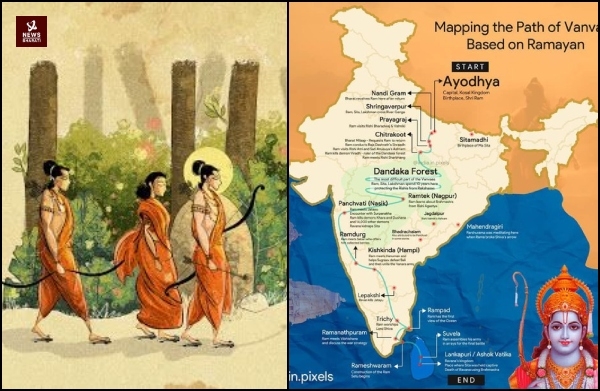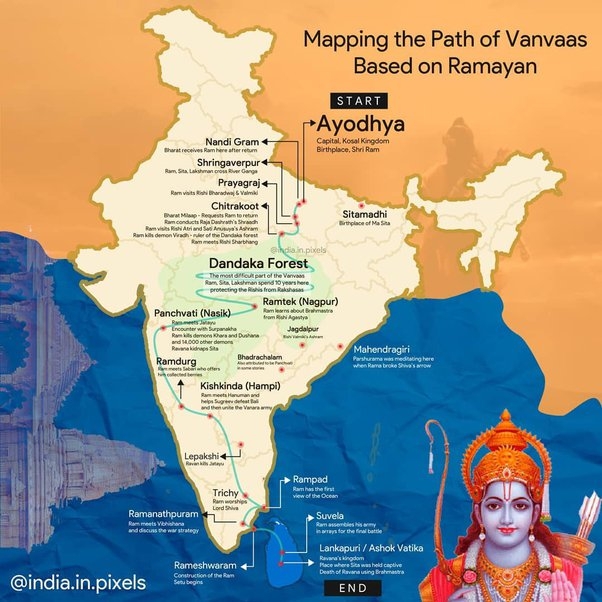Ram Vanvas: An Evidence of Geographical and Social Integration of Bharat
Bhagwan Ram is the most apt icon of cultural nationalism, which encompasses all the people having a deep sense of self-belongingness. But how-
Total Views |
Civic nationalism and cultural nationalism have been a long-time debate since independence. But it has got a new lease because of the changing psyche and new awakening among the countrymen. The debate has its roots even in the pre-independence era but it took a back seat as independence was the top priority. But civic nationalism got a major boost when Jawaharlal Nehru became Prime Minister. Nehru was deeply influenced by Western ideas and had little affection for the ancient history of India and its values. The idea of civic nationalism got political patronage. Congress leaders like Dr Rajendra Prasad, Sardar Vallabhbhai Patel, and K M Munshi represented the concept of cultural nationalism but their views were not given adequate attention because of internal happenings within Congress. However, India continues to face heavy prices because of the idea of civic nationalism.

Advocates of civic nationalism feel that India was born on August 15, 1947. They deny India’s existence since ancient times. They put the theory that India was never a nation but a large subcontinent with small states or kingdoms. They deny culture was a major cementing force to keep India as a dynamic nation, which was sustained despite intrusions and attacks by foreign forces for centuries. They use various terms like liberalism, individual freedom, multiculturalism, and tolerance to support their theory. But they miserably fail to understand that a 'sense of belongingness’ is the major and decisive prerequisite for a nation. This sense of belongingness is born out of love and affection. Indian culture has adhered to certain values for centuries despite political invasions. This is, in fact, the real strength of Indian values as they continue to dominate the psyche of this nation. This is evident despite several unnatural, superficial, and cosmetic features, which are always projected and emphasized to demonstrate the 'so-called lack of unity' of India. This is being done under the garb of diversity.
It is a reality that civic nationalism successfully set its agenda thanks to political patronage for decades. Many people get carried away out of innocence. Indians are deliberately kept in the dark about the cementing forces, which kept them united for centuries. Intellectuals went to the extent of suppressing history or presenting it in a perverted manner, which is a classic case of intellectual dishonesty.
Ram Janmabhoomi, A Cultural Nationalism
People have now realized this intellectual dishonesty and mala fide intentions of supporters of civic nationalism. Cultural nationalism is a widely accepted concept now. Ram Janmabhoomi's agitation is a classic example of cultural nationalism, wherein people supported temples in Ayodhya, brushing aside all the differences and divisive elements. Ramjanmabhoomi agitation was not for any materialistic gain but to assert self-esteem, which was brutally suppressed for generations. Ram, people have realized, is the major binding force, which will keep the Indians united. With the construction of a temple in Ayodhya, Ram is being re-established as a uniting force with renewed energy. Ramjanmabhoomi agitation is the most widely fought agitation in the post-independence era. This agitation will have its logical end after four decades. But to restrain this agitation in a timeframe would be highly unfair, considering its qualitative results. It changed the Indian psyche, which has become nationalistic now. This change was in contrast to what was being planted and planned by supporters of civic nationalism after independence.
Ram continues to influence Indians for thousands of years because of eternal human values in his life. Take the case of Dr Ram Manohar Lohia, who was a socialist thinker and leader. Dr Lohia was an atheist and never believed in God. For him, God was an imaginary idea. But Dr Lohia had extensively written a book – Ram, Krishna, and Shiva, in which he had tried to understand three Indian icons. Dr Lohia has argued in the book that Ram vanvas was an attempt to bring India under one rule as it spread from extreme north to extreme south. Dr Lohia’s argument can be extended to the fact that Ram Vanvas was not merely an advent to ensure the geographical integrity of India but also a unique example of social integration.
Geographical Integrity
Ram Vanvas starts from Ayodhya, which is at the bottom of the Himalayas, a natural boundary for Bharat Varsha. In the Ramayan period, Nepal was part of India. Nepal came into existence in the 18th century. The current boundary between Nepal and India is man-made or artificial. The Himalayan range is the natural boundary for Bharat Varsha. Similarly, Sri Lanka is always considered an extension of Bharat Varsha. The influence of Hinduism and Buddhism is still seen in Sri Lanka. This country was also a victim of colonialism. Significantly, Sri Lanka restored its ancient identity by changing its name from Ceylon to Sri Lanka. The name of Sri Lanka is mentioned in several ancient Indian literature, including Ramayana. Ramsethu, built by Ram’s army of wanar (donkeys) is another testimony to the relation between Sri Lanka Island and the Indian main continent.
If one looks at the journey of Bhagwan Ram from Ayodhya to Sri Lanka, it is found that he covered a major portion of the Indian subcontinent. He traveled from Ayodhya to Sri Lanka passing through areas, which are now known as Uttar Pradesh, Uttarakhand, Madhya Pradesh, Maharashtra, Andhra Pradesh, Telangana, Karnataka and Tamil Nadu. He finally entered Sri Lanka. Barring a few parts of northwestern western, Bhagwan Ram covered almost all the Indian continent during the period of exile.
His journey from Ayodhya to Lanka, through the forests of erstwhile India, is beautifully portrayed with vivid descriptions of the places he traveled through. It has narrations of the night sky and the position of the different stars, to descriptions of the flora, fauna, and landscape of this place. It, thus, describes all the geographical descriptions of the erstwhile Indian subcontinent.

Bhagwan Ram began from Ayodhya and reached to Sri Lanka via Tamsa Nadi Tal (Mardah in Ghazipur district in Uttar Pradesh, Shringaverapura - currently Singraur, in Allahabad (or Prayagraj) in Uttar Pradesh, Chitrakoot in Madhya Pradesh, Sharbhana Muni Ashram, situated in Satna district of Madhya Pradesh, Bhadrachalam, now in Telangana, Ramtek in Maharashtra, Panchwati, now known as Nashik in Maharashtra, Rishyamook Parbat in Koppal district of Karnataka, Pampa Sarovar in Belgavi district of Karnataka, Malay Parbat, along coastal Karnataka, Trichchirappalli in Tamil Nadu and Rameshwaram in Tamil Nadu.
Sri Lanka has at least nine places, which are associated with Bhagwan Ram. They include Nuwara Eliya, Munneswaram Temple, Manavari Temple, Dolukanda Sanjeewanee Mountain, Nilawari, near Jaffna, Laggala, Dunuwila, Yahangala and Divurumpola.
Ram Vanvas Socially Significant, Too
All these places are still held in utter respect since devotees feel privileged as Bhagwan Ram travels through areas. All these places have a significant place in Hindu minds as they are known as sacred and holy towns.
But Bhagwan Ram Vanvas could not be merely seen in geographical terms as it has deep social significance, which reflects the then harmonious and duty-bound social structure. In the current terminology, all the sections of society cooperated with Ram and vice versa. While Ram protected Rushies from the demons, he was helped by Kewat to cross the river Ganga. Ram spent a considerable period of his exile in Dandkranya, where he came into contact with people living in the forest (vanvasi). He stayed in Dandkaranya without any hurdles. It was not possible without the cooperation of the residents, who were tribals.
Panchwati has a special place in Ramayan as major incidents - abduction of Sita, killing of Jatayu, killing of Shurpankha, and getting weapons from Agasti Muni’s Agnishala took place here. Here Ram is seen getting cooperation from all the people. Bhagwan Ram’s attitude can be understood by the fact that he carried out the final rituals of Jatayu like any other human being.
In Aishyamook Parbat area, Ram and Laxman are believed to have met Hanuman, who represents people living in forests. The famous incident of Shabri Mata took place near Pampa Sarovar in the Beelgavi district of Karnataka. Shabri Mata belonged to the Bhill community. The incident of the struggle between Wali and Sugriva also happened during Ram vanvas, when Ram supported Sugriva, who was an aggrieved party and represented deprived and weaker people. Ram also protected Bibhishan, the brother of Ravana, who again represents the weaker section. Bibhishan’s family origin did not prevent Ram from giving him protection. This would have never happened if Ram had some prejudices against others. The mutual friendship between Nishad and Bhagwan Ram is also testimony to the fact that Ram always accorded importance to human relations.
Ram is considered as the incarnation of Vishnu. Some scholars always show differences between Shavites and Vaishanites to harp on the internal struggle in India. Interestingly, Ram is believed to have prayed to Shiva at Munneswaram temple in Sri Lanka. Bhagwan Ram also installed lingam at the Manavari temple in Sri Lanka. Thus, Ram proves that there was no difference between Shavites and Vaishnavites. Both streams are seen united in Ram.
Ram, thus, stands as the biggest icon of integration and social harmony in Indian history. He is the most apt icon of cultural nationalism, which encompasses all the people having a deep sense of self-belongingness.



